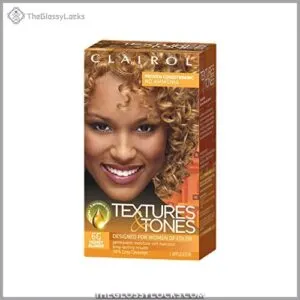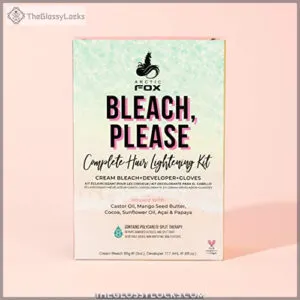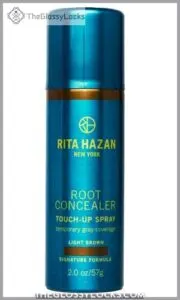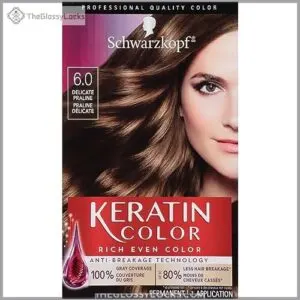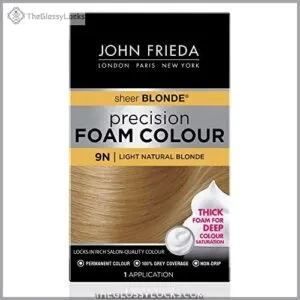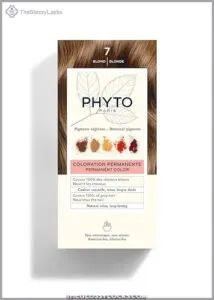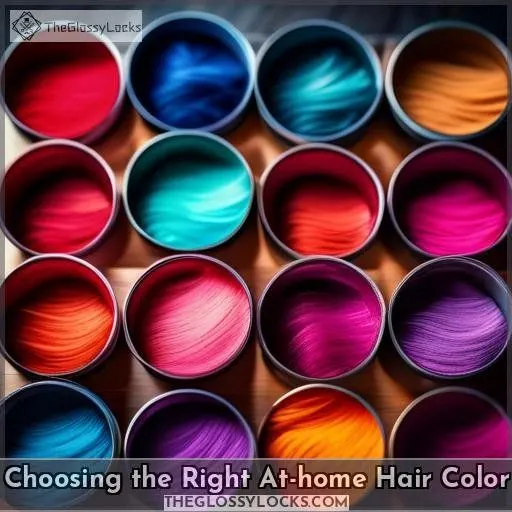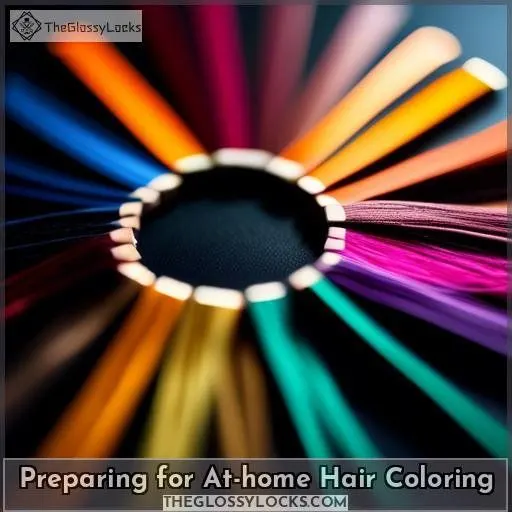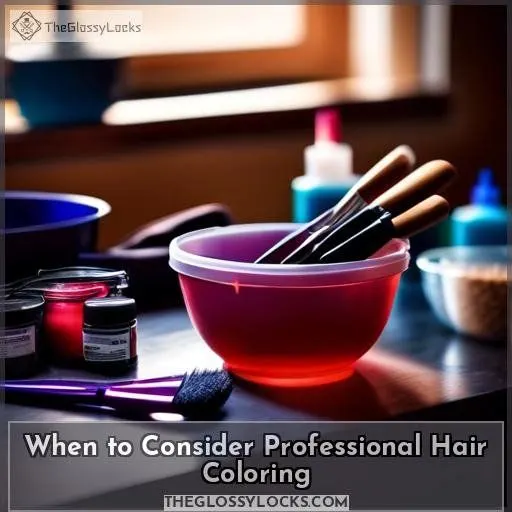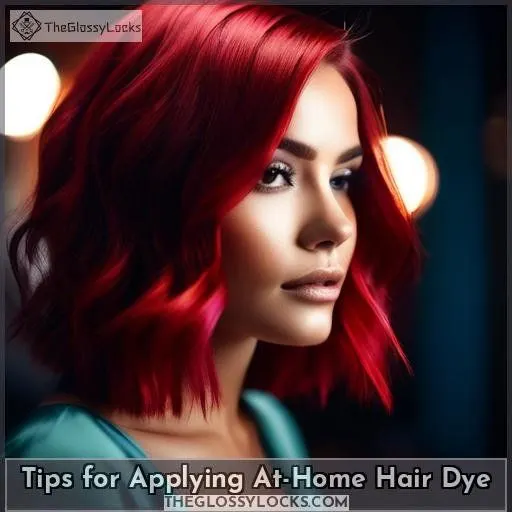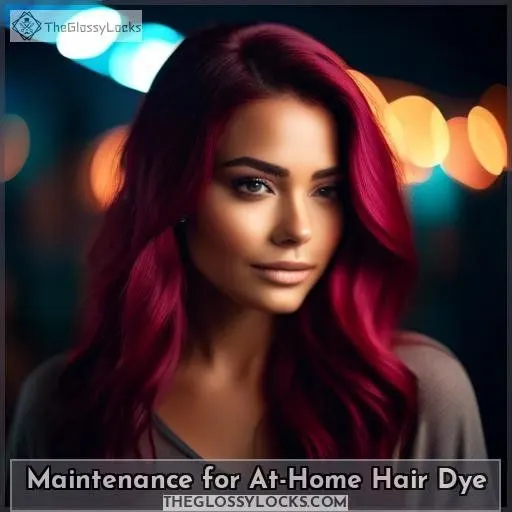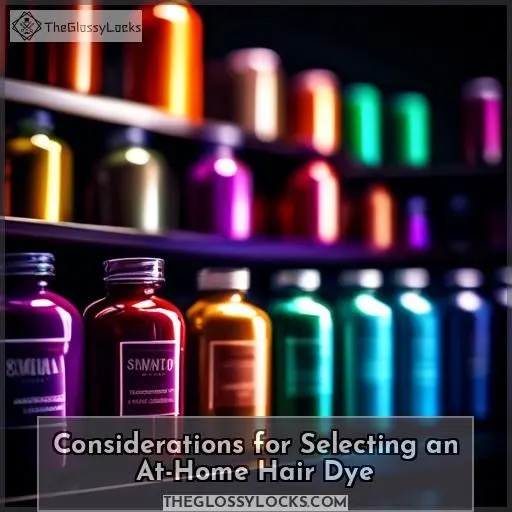This site is supported by our readers. We may earn a commission, at no cost to you, if you purchase through links.

You’ll want to choose the best at-home hair dye that suits your desired color and hair type.
Top picks include L’Oreal’s Colorista Ombre Kit for soft highlights, Revlon Colorsilk for vibrant reds, and Arctic Fox’s Bleach Please for lightening dark hair.
Always do a patch test first.
For ammonia-free options, try brands like Kristin Ess.
Semi-permanent dyes are a lower commitment before going permanent.
Follow instructions diligently – you’ve got this!
To discover more top-rated at-home hair dyes and expert tips, be sure to keep exploring.
Your perfect shade awaits.
Table Of Contents
- Key Takeaways
- Top 10 Best At-Home Hair Dyes
- 1. Kristin Ess Pastel Pink Hair Color Spray
- 2. Clairol Professional Textures Tones Hair Color Honey Blonde
- 3. Arctic Fox Bleach Please Hair Lightening Kit
- 4. Revlon Colorsilk Permanent Hair Color 35 Vibrant Red
- 5. L’Oreal Paris Colorista Hair Bleach Ombre Kit
- 6. Rita Hazan Root Concealer Spray Light Brown
- 7. Schwarzkopf Keratin Color Permanent Hair Dye
- 8. Manic Panic Atomic Turquoise Hair Dye
- 9. John Frieda Precision Foam Color Light Natural Blonde
- 10. Phyto Phytocolor Permanent Hair Color Blonde
- Choosing the Right At-home Hair Color
- Preparing for At-home Hair Coloring
- When to Consider Professional Hair Coloring
- Leave Foil Highlighting and Color Corrections to Professionals
- Avoid Drastic Color Changes at Home
- Use Lightening Agents Only With Professional Guidance to Prevent Scalp Irritation
- Substantially Lightening Hair or Achieving Blonde Hair Should Be Done in a Salon
- At-home Coloring is Best for Maintaining Color Between Salon Visits
- Tips for Applying At-Home Hair Dye
- Enlist the Help of a Professional Colorist for Guidance on Shade Selection and Application
- Watch Tutorial Videos to Familiarize Yourself With the Process
- Ensure You Have All Necessary Tools and Supplies Before Starting
- Do a Patch Test 48 Hours Prior to Check for Any Skin Reactions
- Follow the Instructions Carefully, Including Timing and Application Techniques
- Work in Sections to Ensure Even Coverage
- Use the Provided Applicator Tools for Best Results
- Wear Gloves to Avoid Staining Hands and Surfaces
- Rinse Thoroughly and Use a Color-protecting Shampoo and Conditioner
- Maintenance for At-Home Hair Dye
- Touch Up Roots as Needed to Extend Time Between Full Applications
- Avoid Excessive Heat Styling and Sun Exposure to Prevent Fading
- Schedule Regular Trims to Keep Ends Healthy and Color Looking Fresh
- If the Results Aren’t as Expected, Consult a Professional Colorist for Advice
- Be Patient and Allow Time for the Color to Fully Develop
- Avoid Over-processing or Leaving Color on for Too Long
- Use a Color-depositing Conditioner or Gloss to Refresh Faded Color
- Considerations for Selecting an At-Home Hair Dye
- Frequently Asked Questions (FAQs)
- Conclusion
Key Takeaways
- Choose an at-home hair dye that suits your desired color and hair type, considering top picks like L’Oreal Colorista Ombre Kit, Revlon Colorsilk, and Arctic Fox Bleach Please.
- Perform a patch test beforehand to check for any skin reactions and follow instructions diligently for optimal results.
- Opt for ammonia-free options like Kristin Ess or semi-permanent dyes if you want a lower commitment before going for permanent color.
- Your perfect shade awaits – explore top-rated at-home hair dyes from brands like Kristin Ess, Revlon, L’Oreal, and Manic Panic for vibrant reds, pastel pinks, and more.
Top 10 Best At-Home Hair Dyes
From vibrant reds to pastel pinks, you have a wide array of at-home hair dye options to choose from for achieving gorgeous color from the comfort of your home.
Brands like Kristin Ess, Revlon, L’Oreal, and Manic Panic offer top-rated permanent, semi-permanent, and temporary formulas in various shades.
These formulas allow you to experiment with trendy hues or enhance your natural color with ease.
1. Kristin Ess Pastel Pink Hair Color Spray
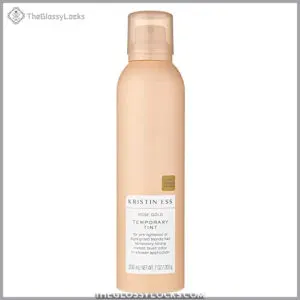
Kristin Ess Pastel Pink Hair Color Spray is a popular choice for those looking for a temporary, in-shower watercolor experience. This product is perfect for adding a temporary rose gold color to blonde or highlighted hair. The intensity of the color can be customized, with more intense results achieved on pre-lightened or highlighted hair. The color washes out in 1-3 shampoos, depending on the porosity of your hair.
To use the spray, follow these steps:
- Shampoo your hair and rinse.
- Apply the spray in the shower on wet hair.
- For a more intense pink color, towel dry the hair before you spray.
- Once you feel you’ve covered the hair you want to color, wait 1-2 minutes and then rinse.
- Follow it up with your favorite conditioner or mask.
The spray is cruelty-free, vegan, and free of parabens, phthalates, and silicones. It also contains Zip-Up Technology, which is a proprietary strengthening complex designed to zip-up split ends while targeting weak areas of the hair, smoothing the appearance of damaged cuticles, and helping protect hair from environmental stressors and color fade.
The application process is straightforward and can be done in the shower, making it a convenient option for those who want to experiment with temporary hair color. However, it’s important to note that the color isn’t suitable for dark hair and may not cover gray hair. Additionally, the spray may drip into the face or spray onto shower walls, and it can be challenging to apply evenly in the shower.
Best For: Blonde or highlighted hair
- Temporary in-shower watercolor experience
- Customizable intensity
- Cruelty-free, vegan, and free of parabens, phthalates, and silicones
- Easy to use
- Lasts for 1-3 shampoos
- Not suitable for dark hair
- May drip into face or spray onto shower walls
- Hard to apply evenly in the shower
2. Clairol Professional Textures Tones Hair Color Honey Blonde
Embark upon the realm of home hair artistry with Clairol Professional Textures & Tones in the radiant hue of Honey Blonde.
This ammonia-free elixir unveils a sanctuary for those yearning for a moisture-infused shade that embraces your unique texture with unwavering affection.
Enriched with Jojoba and an orchestra of botanical essences, it transforms your tresses into a haven of tranquility, bestowing a brilliance that eclipses the celestial orb.
For those graced with abundant hair, a supplementary package may be required to achieve comprehensive coverage.
However, the outcome promises to be a masterpiece, worthy of culinary acclaim!
Vigilantly inspect the expiration date, ensuring you don’t don a relic from a bygone era.
Whether you reign as a 4C empress or simply desire a touch of auburn, this dye holds the key to a vibrant, enduring color that will triumphantly conceal those pesky silver strands.
Best For:
Clairol Professional Textures & Tones Honey Blonde is best for individuals who want an ammonia-free hair color that is moisturizing and suitable for textured hair. It is ideal for those who want a color that is easy to apply without damaging locs and is suitable for both natural and relaxed hair types.
- Ammonia-free formula, making it gentle for all hair types
- Enriched with Jojoba and five botanical extracts for moisture and conditioning
- Deep-conditioning Soy Complex for shine and conditioning
- Mixes with a dedicated developer for bowl-and-brush application
- Provides 46 permanent creme hair colors to choose from
- Suitable for both natural and relaxed hair types
- Easy to use without damaging locs
- Contains a powder booster pack to enhance color
- May require multiple boxes for thick hair
- Hard to find ginger colored dyes
- May not provide desired results on 4C hair type
- Check date before use to ensure product is not expired
3. Arctic Fox Bleach Please Hair Lightening Kit
If you’re aiming to lighten your locks without a trip to the salon, the Arctic Fox Bleach Please Hair Lightening Kit might just be your new best friend.
This kit is a powerhouse, lifting hair up to 8 levels while pampering your strands with nourishing ingredients like acai and castor oil.
It’s like a spa day for your hair!
Plus, it’s vegan and cruelty-free, so you can feel good about your choice.
Just remember, it’s strong stuff, so keep an eye on the clock and follow the instructions to a T to avoid any hair-raising surprises.
Best For:
- People who want to lighten their hair up to 8 levels at home
- Those who prefer a vegan and cruelty-free hair lightening kit
- Individuals who want to pamper their hair with nourishing ingredients
- Lifts hair up to 8 levels
- Contains vegan and cruelty-free ingredients
- Nourishes hair with acai and castor oil
- Strong, so watch carefully
- Must mix thoroughly
- May not work well on light or warm colors
4. Revlon Colorsilk Permanent Hair Color 35 Vibrant Red
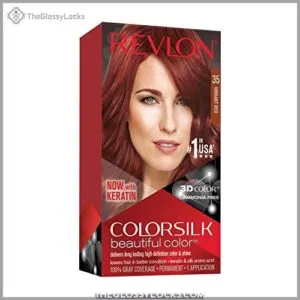
The Revlon Colorsilk Permanent Hair Color 35 Vibrant Red is a favored choice for those seeking a long-lasting, vibrant hair color from the comfort of their own home. This ammonia-free formula is enriched with Keratin and Silk Amino Acid, which leaves hair in better condition than before coloring, making it a gentle and nourishing option. The 3D Color Gel Technology in this product delivers multi-tonal color from root to tip, ensuring a natural-looking, well-defined result.
To achieve the best results with the Revlon Colorsilk Permanent Hair Color 35 Vibrant Red, follow these steps:
- Mix: Pour the ammonia-free colorant into the cream developer bottle and shake until the mixture is completely blended.
- Apply: Part your hair into 4 equal sections and apply the dye mixture one section at a time, starting at the roots.
- Leave in: Apply the remaining product through the rest of your hair and massage your strands gently until your hair is completely coated. Leave the mixture on for 25 minutes.
- Rinse: Gently rinse your hair with warm water until the water runs clear.
- Condition: Apply the ultra-hydrating cream conditioner after color application and leave it on for 3 minutes before rinsing with warm water.
Remember to perform a patch test 48 hours before coloring to check for any skin reactions, and follow the instructions carefully for ideal results.
Best For: Individuals seeking an easy-to-use, ammonia-free home hair dye solution that provides 100% gray coverage and a natural-looking, vibrant red color.
- Enriched with Keratin and Silk Amino Acid for healthier hair post-coloring
- Utilizes 3D Color Gel Technology for a natural-looking, multi-tonal effect
- Comes with an ultra-hydrating cream conditioner for silky smooth hair after use
- Color may fade within 3-4 washes, particularly on gray hair
- May be considered semi-permanent compared to salon treatments
- Requires a patch test 48 hours before use to check for skin reactions
5. L’Oreal Paris Colorista Hair Bleach Ombre Kit
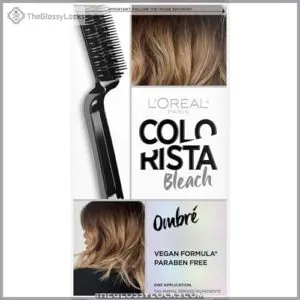
Ready to achieve an ombre effect at home? The L’Oréal Paris Colorista Bleach Ombre Kit is your go-to solution. This customizable hair bleach kit allows you to lighten all over, create highlights, or even an ombre effect to customize your unique Colorista look.
The kit comes with a lightening cream, a precise applicator brush, and gloves, giving you the power to create your desired look. The ammonia-free hair color formula is enriched with oil for maximum hair care, ensuring your hair stays soft and undamaged. Plus, the anti-brass purple conditioner neutralizes brassy tones and eliminates unwanted yellow colors, leaving your hair looking vibrant and healthy.
To use the L’Oréal Paris Colorista Bleach Ombre Kit, follow these steps:
- Choose your desired look and lighten the strands where you want your Colorista Semi-Permanent Color to be the most visible.
- Always refer to the instruction sheet inside each individual product.
- Perform a skin allergy test 48 hours before each application of the anti-brass conditioner.
Best For:
The L’Oréal Paris Colorista Bleach Ombre Kit is best for individuals who want to achieve an ombre effect on their hair at home. It is suitable for those with dark brown hair and is easy to use, even for beginners.
- Customizable hair bleach kit allows for lightening all over, creating highlights, or an ombre effect
- Ammonia-free hair color formula enriched with oil for maximum hair care
- Anti-brass purple conditioner neutralizes brassy tones and eliminates unwanted yellow colors
- Suitable for dark brown hair and works quickly and effectively
- Leaves hair soft and undamaged
- May require multiple boxes for longer or thicker hair
- Follow up with a protein filler to keep hair healthy
6. Rita Hazan Root Concealer Spray Light Brown
Rita Hazan Root Concealer Spray Light Brown is a convenient and effective solution for covering gray roots and extending the life of your salon color between visits.
This water-resistant and transfer-proof touch-up spray is perfect for those who want to maintain their hair color without the commitment of permanent dye.
It’s easy to use, with a pinpoint actuator that allows for precise application, and the color stays in place without staining your face, clothing, or linens.
The spray is formulated without ammonia and peroxide, making it safe for all hair types and textures.
It’s available in a variety of shades, including light brown, which covers lighter brown shades like chocolate, chestnut, and amber.
To use, simply shake the can well before each use, hold it 4-6 inches from your roots, and spray in a light, steady stream.
The color pigments are buildable and will last until your next shampoo.
Best For:
The Rita Hazan Root Concealer Spray Light Brown is best for individuals with light brown hair who want to cover gray roots and extend the life of their salon color between visits. It is suitable for all hair types and textures, and it is safe for use on color-treated hair.
- Conceals gray roots: The spray is designed to cover gray roots, making it an ideal solution for those who want to maintain their hair color without the commitment of permanent dye.
- Quick-drying: The product is quick-drying, allowing users to apply it and go without waiting for it to set.
- Transfer-proof: The formula is transfer-proof, ensuring that the color stays in place without staining clothing, linens, or skin.
- Salon-quality: The product is salon-quality, providing professional-grade results for at-home use.
- Safe for color-treated hair: The spray is formulated without ammonia and peroxide, making it safe for use on color-treated hair.
- Does not affect relaxers or other straightening treatments: The product is designed not to affect relaxers or other straightening treatments, making it suitable for individuals with chemically treated hair.
- Limited availability: The product may be difficult to find in physical stores, as it is primarily available online.
- Possible staining: Some users have reported that the product can stain clothing if not applied carefully.
- May require frequent reapplication: Depending on the individual’s hair growth rate, the product may need to be reapplied more frequently to maintain the desired coverage.
7. Schwarzkopf Keratin Color Permanent Hair Dye
Embark on the journey of home hair coloring with Schwarzkopf Keratin Color Permanent Hair Dye, a treasure that has adorned tresses since 1898.
This isn’t just an ordinary dye; it’s a salon encapsulated, prepared to bestow an opulent, uniform hue that honors your hair’s natural essence and curl definition.
Envision your hair’s metamorphosis with a concoction that not merely pigments but also nurtures, diminishing frizz and imbuing your hair with a silky embrace.
With up to 10 weeks of resplendent color, it’s akin to granting your hair a daily spa retreat.
Why settle for mediocrity when you can embrace excellence?
Schwarzkopf Keratin Color is your gateway to captivating gazes without venturing beyond your doorstep.
Best For:
Best For: Women who want a salon-quality hair color experience at home, with a product that maintains their hair’s natural texture and curl pattern, and provides up to 10 weeks of long-lasting color.
- Provides a rich, even color that maintains the hair’s natural curl pattern and texture
- Nourishes the hair with a deep conditioning effect, leaving it feeling soft and smooth
- Contains an anti-fade formula for long-lasting color
- Easy to apply with a 3-step bond enforcing system
- Suitable for all hair textures and lengths
- May require repeat application every 4 weeks for even color from root to tip
- Some users have reported that the color fades quickly, requiring more frequent touch-ups
- The pre-color serum may not be effective for everyone, as some users have reported skin irritation or allergic reactions
8. Manic Panic Atomic Turquoise Hair Dye
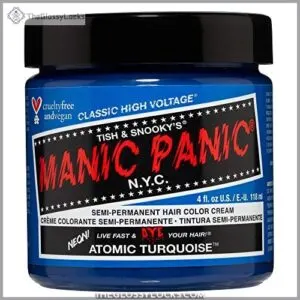
Looking to add a splash of color to your hair without leaving the comfort of your home? Manic Panic Atomic Turquoise Hair Dye is a vibrant, semi-permanent option that can help you achieve a stunning aqua blue hue. Here’s what you need to know about this product:
Color and Shade: The Atomic Turquoise hair dye from Manic Panic is a bright, radiant aqua blue color with green undertones. It can add turquoise tones to virgin, unbleached hair, but looks its best when hair is lightened to the lightest level 10 blonde.
Formula: This dye is semi-permanent, which means it gradually fades in 4-6 weeks. It’s PPD, ammonia, paraben, gluten, and phthalate-free, making it a cruelty-free and vegan choice.
Application: To get the best results, Manic Panic recommends toning hair that has yellow tones before use to avoid undesired hues. It’s also important to pre-lighten your hair to a pale blonde (level 9-10) for the most intense results.
Maintenance: Each application lasts 6-8 weeks on pre-lightened hair. To maintain the color, consider using a color-safe shampoo and conditioner, and avoid excessive heat styling and sun exposure.
Reviews: Users have praised the product for its vibrant color, ease of use, and long-lasting results with proper care. However, some have noted that it may not show up well on dark hair without bleaching, and can be messy to apply.
Considerations: If you’re considering Manic Panic Atomic Turquoise Hair Dye, remember to lighten your hair to the recommended level before application, and consider using a bleaching kit like the Manic Panic Flash Lightning Kit to prepare your hair for the dye. Also, be aware that the color may appear more teal or green on some hair types, so it’s crucial to choose a shade that complements your natural hair color.
Best For:
Manic Panic Atomic Turquoise Hair Dye is best for individuals with lightened or bleached hair who want to add turquoise tones to their hair.
- Bright aqua blue hair dye with green undertones
- Mixable colors and tones
- Semi-permanent hair dye that gradually fades in 4-6 weeks
- Cruelty-free and vegan formula
- PPD, ammonia, paraben, gluten, and phthalate-free
- May not show up well on dark hair without bleaching
- Can be messy to apply
- Requires careful maintenance to prevent fading
9. John Frieda Precision Foam Color Light Natural Blonde
Looking for a salon-quality hair color experience at home? John Frieda Precision Foam Color Light Natural Blonde 9N is a fantastic option for you.
This non-drip foam formula allows for easy application, preventing messy drips and unwanted patches.
It offers 100% gray coverage, ensuring that your hair is evenly colored from root to tip.
The long-lasting formula is fade-resistant, giving you confidence in your blonde shades.
After coloring, use the nourishing after-color conditioner to enhance your color and keep your hair soft and silky.
With a variety of shades to choose from, you can achieve a natural-looking blonde color that suits your skin tone.
Best For: Individuals seeking an easy-to-use, salon-quality hair dye that offers full coverage, including 100% grey coverage, and comes with a nourishing conditioner for long-lasting color.
- Non-drip foam formula ensures a clean, easy application without mess.
- Provides 100% grey coverage for a uniform, natural-looking hair color.
- Includes a nourishing post-color conditioner that seals in color and keeps hair soft and silky.
- Limited to individuals who desire the specific shade of Light Natural Blonde.
- May not achieve desired results if natural hair color is more than two shades lighter or darker than the product shade.
- Satisfaction guarantee is offered, but limitations may apply, which could affect returns or refunds.
10. Phyto Phytocolor Permanent Hair Color Blonde
Phyto Phytocolor Permanent Hair Color Blonde is a top pick for at-home hair dye due to its natural, ammonia-free formula and 100% gray hair coverage from the first application.
It’s enriched with botanical pigments for a natural, intense shade and extreme brilliance.
The pack includes a Milk developer bottle, Coloring Cream, a Color Protecting Mask, and instructions.
It’s suitable for normal to dry hair and normal to sensitive scalps.
The product has a mild scent and is PPD-free, resorcinol-free, and ammonia-free.
It’s recommended to use two kits for the first application on long or very thick hair.
For best results, it should be applied on healthy hair and wait 2 weeks before coloring if you’ve had a perm or a hair-relaxing treatment.
Best For:
Phytocolor Permanent Hair Color Blonde is best for individuals who want to color their hair at home with a natural, ammonia-free formula that provides 100% gray hair coverage. It is suitable for normal to dry hair and normal to sensitive scalps.
- Enriched with botanical pigments for a natural, intense shade and extreme brilliance
- PPD-free, resorcinol-free, and ammonia-free
- Respectful of the scalp with a mild scent
- Includes a Milk developer bottle, Coloring Cream, Color Protecting Mask, and instructions
- Suitable for normal to dry hair and normal to sensitive scalps
- Covers 100% of gray hair
- No chemical smell
- Easy-to-read instructions
- Color may appear to dry up during application
- Color may appear 1 to 2 shades darker than what is on the box
- Thick hair may require 2 boxes
- May not be suitable for all hair types
- May not be suitable for all hair types
- Thick hair may require 2 boxes
- Color may appear 1 to 2 shades darker than what is on the box
- Color may appear to dry up during application
Choosing the Right At-home Hair Color
You want gorgeous, vibrant hair color without leaving home? Start by determining your desired shade – it’s best to stay within 2-3 shades of your natural hue for seamless blending. And always refer to the hair color swatch, not the product image, for an accurate depiction of the final result.
Determine Desired Color Goal
Determining your desired color objective is critical when selecting the ideal home hair color.
Consider your hair’s well-being, color retention, and personal preferences.
It’s imperative to be aware of the potential risks associated with DIY hair coloring, including allergic reactions, damage, and uneven outcomes. Alternative methods, such as salon appointments or professional colorists, can provide more customized and safer options.
When choosing a hair dye, consider factors like ammonia content, temporary or permanent dyes, and your hair type.
Hair color swatches can help you visualize the final result.
Opt for a Shade Close to Natural Hair Color
When selecting a hair color for home use, it’s imperative to choose a shade that aligns closely with your natural hair tone. This is because permanent hair dyes typically contain potent developers that have the ability to lighten your hair, resulting in a shade that may appear darker than anticipated from the box. By opting for a shade that’s similar to your natural hair color, you can mitigate the potential for hair damage and achieve a more accurate representation of the desired color.
Furthermore, if you have gray hair, it’s paramount to contemplate the most effective hair color option. Permanent hair color may be the ideal solution for complete coverage, as semi- or demi-permanent hair dyes often provide limited coverage and may fade more rapidly. When selecting a shade for gray hair, experts advise choosing a color that’s marginally lighter than the gray color, as lighter shades are more readily absorbed by the hair than darker shades.
Refer to Hair Swatch for a Better Representation of Color
After zeroing in on a shade that whispers this is me, it’s time to get real with color matching.
A hair swatch isn’t just a suggestion—it’s your roadmap to color success.
Think of it as the GPS for your hair color journey, ensuring the shade you dream of matches your hair’s undertones.
It’s the secret sauce to nailing that salon-fresh look at home.
Ensure Sufficient Hair Dye for Hair Length and Thickness
To guarantee adequate hair dye for hair length and thickness when utilizing at-home hair dye, adhere to these guidelines:
- For short hair (above the shoulders), one box of hair dye should be sufficient for a single application. Nevertheless, if you possess voluminous or textured hair, you may require an additional box to secure complete coverage.
- For medium-length hair that falls between the shoulders and mid-back, it’s advisable to utilize two boxes of hair color for thorough coverage. Once more, this may fluctuate contingent upon your hair density, shoulder length, and texture.
- For long hair (past mid-back), it’s optimal to procure three boxes of hair dye for full coverage. This extra dye may appear superfluous, but bear in mind that longer hair necessitates more product to saturate and evenly distribute color.
Read Instructions, Warnings, and Application Methods Carefully
When selecting an at-home hair dye, it’s essential to meticulously review the instructions, cautions, and application techniques.
This entails comprehending the application duration, dye selection tailored to hair texture and desired color persistence, and the potential for hair damage.
For highlights, envision employing a hair color spray or highlighting kit.
Color creams and color-enhancing products can amplify your current color.
Bear in mind that meticulousness and a touch of patience can significantly contribute to attaining your desired appearance.
Preparing for At-home Hair Coloring
You’ll want to devote around two hours to properly apply at-home hair color. Gather all the necessary tools – gloves, bowls, brushes, and applicators – before starting, then section your hair for even dye application. Apply the color in thin, neat sections to ensure optimal saturation, and always do a patch test first to check for any skin reactions.
Allocate Approximately Two Hours for the Process
Set aside approximately two hours for the hair coloring process.
This entails time for application, processing, and rinsing.
It’s imperative to plan ahead and allocate sufficient time to guarantee a comprehensive and uniform application of the hair dye.
Therefore, ensure you have ample time to adhere to the instructions meticulously and allow the dye sufficient time to develop optimally.
Gather Necessary Tools (gloves, Bowls, Brushes, Applicators)
Prior to embarking on the realm of home hair dyeing, it’s imperative to prepare yourself and your tresses for the endeavor. Assembling the requisite tools and materials is paramount to achieving a successful hair coloring outcome. Here’s what you’ll need:
- Gloves: Shield your hands from the dye and facilitate a hygienic application process.
- Bowls: Combine your hair dye and activator in these bowls to prevent cross-contamination.
- Brushes: Employ a synthetic-bristled brush for liquid formulations and a foam brush for mousse-based products.
- Applicators: A narrow, plastic spatula assists in sectioning hair for highlights or root touch-ups.
- Cornstarch: Incorporate a small quantity into your dye to enhance its consistency and minimize drips, particularly for highlights or root touch-ups.
- Salad oil mister: Apply olive or coconut oil in mist form to coarse or curly hair prior to coloring to safeguard against damage.
- Color-safe shampoo and conditioner: Utilize these products to sustain your hair color post-dyeing.
Section Hair Properly for Even Application
Once you’ve got your gloves on and tools ready, it’s time to tackle sectioning.
Think of your hair as a canvas for color.
Sectioning techniques are your brushstrokes for masterpiece results.
Divide your locks into manageable segments, ensuring even application.
Tips are a cinch to follow.
Apply Hair Dye in Thin, Neat Sections for Optimal Color Saturation
To attain the most desirable outcomes with home hair color, it’s essential to distribute the dye in narrow, tidy portions for maximized color absorption. Here are a few suggestions:
- Utilize a brush for application to guarantee uniform coverage.
- Separate your hair into sections prior to initiating the coloring process.
- Apply the hair dye to each section meticulously, making certain to encompass all areas.
- For touch-ups or root concealments, employ a hair color touch-up spray or root concealment product.
Perform a Patch Test to Check for Skin Reactions
Perform a patch test to check for skin reactions before applying hair dye at home. This simple precaution helps prevent irritation and allergic reactions.
Follow the manufacturer’s instructions for DIY allergy testing, using a small amount of hair dye on your skin behind your ear or on your wrist. Wait 48 hours and look for signs of redness, itching, or swelling.
If you’re sensitive, consider a different hair color or seek professional help.
When to Consider Professional Hair Coloring
At-home hair color can be convenient and affordable for touch-ups or minor changes. However, you should leave complex techniques like foil highlighting, drastic color shifts, and substantial lightening to trained professionals.
Working with bleach or high-volume developers at home risks scalp irritation, uneven results, and potential hair damage. To achieve dramatic changes or a complete overhaul of your hair color safely, do it under the guidance of an experienced colorist.
Leave Foil Highlighting and Color Corrections to Professionals
Concerning color correction, bleaching methods, and at-home hair treatments, it’s advisable to entrust these duties to experts. Color correction is a multifaceted procedure that necessitates a thorough grasp of hair textures, complexions, and intended outcomes. Bleaching techniques can be perilous, particularly when performed at home, and may result in chemical burns or other harm if not executed properly. DIY hair care, while practical, may not yield the same salon-caliber results as professional color correction or hair color gel.
Professionals are equipped to conduct these procedures safely and efficiently, guaranteeing that your hair remains undamaged throughout the coloring process. Additionally, they can suggest the most effective hair color conditioning products to preserve your color between salon appointments. By relying on professionals for your hair color requirements, you can steer clear of potential risks and attain a more radiant, enduring color.
Avoid Drastic Color Changes at Home
When it pertains to significant color alterations at home, seeking guidance from a skilled colorist is always prudent.
Exploring different hair colors can be enjoyable, but it’s essential to bear in mind that your natural hair hue serves as the foundation for any alterations.
If you’re faced with gray hairs, opt for a root spray or root repair kit to sustain a more natural appearance.
Additionally, be aware of color stains and employ a hair color stain remover if necessary.
Always remember, your hair is a reflection of who you are. Nurturing it entails recognizing your boundaries and seeking professional counsel when required.
Use Lightening Agents Only With Professional Guidance to Prevent Scalp Irritation
Dabbling in home bleaching? Hold that thought!
Without a professional’s touch, you’re playing with fire—or rather, risking scalp irritation.
Lightening agents are no joke; they demand respect.
Opt for ammonia-free or low-ammonia formulas to avoid burning.
Leave the heavy lifting to the professionals and dodge hair color damage.
Substantially Lightening Hair or Achieving Blonde Hair Should Be Done in a Salon
When it comes to significantly brightening hair or obtaining blonde locks, it’s prudent to entrust the task to experts.
Attempting home bleaching carries risks, potentially resulting in hair damage, the need for color corrections, or even skin irritation.
Consulting a salon is paramount for acquiring a reliable and effective lightening solution or blonde hair dye.
At-home Coloring is Best for Maintaining Color Between Salon Visits
At-home hair coloring is best for maintaining color between salon visits.
It’s a great way to keep your hair looking fresh without the need for frequent professional touch-ups.
When choosing an at-home hair dye, consider factors like color preservation and touch-up frequency.
Opt for products that offer long-lasting results, such as Clairol Nice ‘n Easy Permanent Hair Color, Clairol Root Touch-Up by Nice ‘n Easy Permanent Hair Dye, and L’Oreal Paris Excellence Creme Permanent Triple Care Hair Color.
For those with gray hair, Schwarzkopf Keratin Color Permanent Hair Color and Madison Reed Radiant Hair Color Kit are excellent options.
Tips for Applying At-Home Hair Dye
You’ll want to enlist a professional colorist’s guidance on shade selection and application techniques to ensure success. Watching tutorials and closely following instructions – including doing a patch test, working in sections, using the provided tools and products correctly, and rinsing thoroughly – will help you achieve gorgeous, even color at home.
Enlist the Help of a Professional Colorist for Guidance on Shade Selection and Application
Enlisting the assistance of a professional colorist can make a world of difference regarding selecting the ideal hue and obtaining an impeccable application.
An expert can offer invaluable advice on shade compatibility and application methodologies, guaranteeing a result akin to that of a salon.
They can also provide direction on how to preserve your color’s vibrancy between appointments.
By soliciting their guidance, you can rest assured that your hair is in capable hands.
Watch Tutorial Videos to Familiarize Yourself With the Process
Watching tutorial videos can be an invaluable resource in the domain of home hair dyeing.
These videos offer expert guidance on shade selection and application methods, aiding you in evading prevalent errors and attaining optimal outcomes.
They also impart knowledge on managing skin responses, including patch tests, and furnish advice on employing ammonia-free or low-ammonia formulations for a milder application.
By viewing these tutorials, you can gain proficiency in the process and bolster your confidence in achieving salon-caliber hair color from the sanctuary of your own home.
Ensure You Have All Necessary Tools and Supplies Before Starting
To guarantee a prosperous at-home hair dyeing endeavor, it’s imperative to amass all indispensable implements and provisions prior to commencing the undertaking.
This encompasses a hair dye applicator, a receptacle for commingling the dye, an implement for thoroughly agitating the dye, a utensil for segregating hair when performing highlights, and a thickening agent to enhance the dye’s consistency and obviate drips.
Furthermore, a spray bottle with olive or coconut oil can be used to protect coarse or curly hair before the coloring process.
A restorative kit, conditioning shampoo, and a toning brush are also essential for preserving and enhancing the color over time.
Do a Patch Test 48 Hours Prior to Check for Any Skin Reactions
Performing a patch test before using hair dye is essential to avoid allergic reactions or skin irritation.
Allergic reactions to hair dye are uncommon but can happen.
Symptoms include itching, redness, swelling, and even anaphylaxis in severe cases.
The most prevalent allergen in hair dye is para-phenylenediamine (PPD), which can lead to contact dermatitis.
To conduct a patch test, combine a small portion of the hair dye formula with the activator.
Apply it behind your ear or on a less noticeable area of your skin.
Leave it on for 48 hours before washing it off.
If you encounter any signs of an allergic reaction, such as itching, redness, or swelling, refrain from using the product.
Reach out to the manufacturer for a refund.
Follow the Instructions Carefully, Including Timing and Application Techniques
When it comes to applying at-home hair dye, meticulous adherence to the instructions is essential. This encompasses timing and application methods.
For bleaching, non-permanent color like demi-permanent dye or semi-permanent tint is suggested.
Temporary hair color can also be an enjoyable choice for redheads or brunettes.
Hair color for gray coverage may warrant additional consideration, so make sure you’re utilizing the appropriate shade and application technique.
Sulfate-free hair color is a milder option for those with sensitive scalps.
Work in Sections to Ensure Even Coverage
To guarantee thorough coverage when dyeing your hair independently, it’s essential to divide it into sections. Here are four strategies to maximize your sectioning techniques:
- Detangle and Partition Your Hair: Start by brushing your dry hair to remove knots, then divide it into manageable portions.
- Select Appropriate Section Size: The size of your sections will depend on the thickness and length of your hair. Typically, sections should be approximately two inches in size for uniform color saturation.
- Color Your Length: Apply the dye to your sections, starting from the roots and meticulously working your way down to the ends. Be generous with the dye to ensure full coverage.
- Focus on the Posterior: The back of your head can be difficult to reach, so use your fingers to gently massage the dye into your roots, distributing it evenly.
Use the Provided Applicator Tools for Best Results
To accomplish exceptional outcomes in the comfort of your own home, it’s essential to utilize the accompanying applicator tools.
These implements are meticulously crafted for at-home application, ensuring uniform color absorption and salon-worthy results.
By adhering to the manufacturer’s guidance and employing these tools, you’ll discover that your hair color achieves a paraben-free, customizable, pristine, reinforcing, and evenly distributed finish.
Don’t overlook this step, as it’s a catalyst for a transformative at-home hair color experience.
Wear Gloves to Avoid Staining Hands and Surfaces
Wearing gloves is an essential safety precaution when applying at-home hair dye.
It prevents staining your hands and surfaces, ensuring a clean application process.
Gloves also help maintain color blending and prevent hair damage.
When using a custom hair color kit like eSalon or a professional hair color like Clairol Nice ‘n Easy Permanent Hair Color, gloves are indispensable for a successful outcome.
Remember to wear gloves and follow the application techniques carefully to avoid any mishaps.
Rinse Thoroughly and Use a Color-protecting Shampoo and Conditioner
After applying your home hair dye, it’s essential to rinse thoroughly to guarantee all dye is removed from your hair.
This step is fundamental for color conservation and preserving the vitality of your hair.
Once you’ve rinsed, use a color-protecting shampoo and conditioner to further safeguard your hair from damage and discoloration.
Some suggested products include Phyto Phytocolor Permanent Hair Color, Revlon Colorsilk Beautiful Color Permanent Hair Color, Zotos Professional AgeBeautiful Permanent Liqui-Creme Hair Color Dye Starter Kit, Clairol Natural Instincts Semi-Permanent Hair Color, and Clairol Nice ‘n Easy Permanent Hair Color.
Maintenance for At-Home Hair Dye
You’ve successfully colored your hair at home, but the work doesn’t stop there.
To maintain your gorgeous new shade, touch up your roots every 4-6 weeks.
Avoid excessive heat styling and sun exposure.
Schedule regular trims to keep your ends fresh.
If the color doesn’t turn out as expected, don’t panic.
Consult a professional colorist for advice on how to refresh or correct it.
Touch Up Roots as Needed to Extend Time Between Full Applications
After mastering the initial dye job, preserving the vibrancy of your color is paramount.
Enhancing roots with products like Clairol Root Touch-Up by Nice’n Easy or L’Oréal Paris Excellence Creme guarantees your locks remain impeccable.
Supplement with home remedies and Overtone Daily Conditioner to sustain hair health.
Refining application techniques with Clairol Nice ‘N Easy or L’Oréal Paris Couleur Experte prevents color from diminishing into obscurity.
Avoid Excessive Heat Styling and Sun Exposure to Prevent Fading
To guarantee that your at-home hair color endures as long as possible, abstain from extreme heat styling and sunlight exposure.
The sun’s rays can diminish your color.
While heat styling can damage your hair, resulting in a less vibrant appearance.
To safeguard your hair, employ heat-protectant products.
Minimize sun exposure.
Additionally, consider utilizing color-depositing conditioners or glosses to revitalize your color between applications.
By implementing these measures, you can enjoy your new hair color for as long as possible.
Schedule Regular Trims to Keep Ends Healthy and Color Looking Fresh
Don’t let your color fade away! Schedule regular trims to keep your ends healthy and your color looking fresh. Here’s what you can do:
- Trim Every 6-8 Weeks: Regular trims help maintain hair growth and prevent color damage.
- Home Remedies: Try using coconut oil or apple cider vinegar as a deep conditioner to enhance dye maintenance.
- Fade Resistance: Use fade-resistant products like Clairol Nice ‘n Easy Permanent Haircolor or L’Oréal Paris Excellence Creme Permanent Triple Care Hair Color.
- Color Depositing Masks: Moroccanoil Color Depositing Masks or L’Oréal Paris Couleur Experte Color + Highlights in a Flash can help refresh your color between dye jobs.
If the Results Aren’t as Expected, Consult a Professional Colorist for Advice
If the results aren’t as anticipated, consult a professional colorist for guidance.
Color dissatisfaction can originate from application concerns or hair deterioration.
Product choice and time limitations are essential elements in obtaining the sought-after outcome.
Consider Clairol Nice ‘n Easy Permanent Haircolor or L’Oreal Paris Excellence Creme Permanent Triple Care Hair Color for salon-quality results.
For swift touch-ups, try Clairol Root Touch-Up by Nice ‘n Easy Permanent Hair Dye or L’Oreal Paris Couleur Experte Color + Highlights in a Flash.
The most effective hair dye for home use requires comprehending your hair type, skin tone, desired results, and adhering to correct application methods.
Be Patient and Allow Time for the Color to Fully Develop
After applying your at-home hair dye, resist the urge to rush the waiting time. The color needs to fully develop to guarantee even, long-lasting results. Here are some tips to help you wait it out:
- Follow the product instructions carefully, as waiting times may vary.
- Use this time to relax and enjoy a movie, book, or a warm bath.
- Avoid touching your hair or using heat styling tools during this period.
- Consider using a color-protecting mask or conditioner to keep your hair hydrated.
- If you’re unsure about the waiting time, consult the product instructions or customer service for clarification.
Avoid Over-processing or Leaving Color on for Too Long
Avoid over-processing or leaving color on for too long to prevent hair damage, skin irritation, color unevenness, and application mistakes. Follow the instructions carefully, including timing and application techniques. Use the provided applicator tools for best results. Wear gloves to avoid staining hands and surfaces. Rinse thoroughly and use a color-protecting shampoo and conditioner.
Use a Color-depositing Conditioner or Gloss to Refresh Faded Color
After dodging the over-processing bullet, it’s time to keep your color looking snappy.
Enter color-depositing conditioners and glosses—your secret weapons for vibrancy preservation.
These nifty products are like a spa day for your strands, offering a quick dye touch-up and a color refresh that keeps your hair health in check.
It’s the perfect pick-me-up for your locks, ensuring your hue stays true.
Considerations for Selecting an At-Home Hair Dye
When selecting an at-home hair dye, consider your hair type, skin tone, and desired results – these factors will help you narrow down the best formula for achieving your color goals.
Opt for ammonia-free or low-ammonia dyes for a gentler application.
Explore temporary, semi-permanent, or demi-permanent options if you don’t want a full commitment to permanent color.
Be cautious with at-home bleaching, as it’s risky and requires careful attention to instructions.
Consider Your Hair Type, Skin Tone, and Desired Results
When choosing an at-home hair dye, consider your hair health, skin sensitivity, and scalp protection. Here are three key points to keep in mind:
- Hair Health: Opt for formulas that nourish and protect your hair, leaving it soft and shiny. Look for products with natural ingredients and conditioning agents to keep your hair healthy and vibrant.
- Skin Sensitivity: If you have sensitive skin, choose dyes that are hypoallergenic and gentle on your scalp. Avoid harsh chemicals like ammonia and sulfates, which can irritate your skin.
- Scalp Protection: Some dyes can cause irritation or damage to your scalp. Look for formulas that are designed to protect your scalp, such as those with aloe vera or other soothing ingredients.
Opt for Ammonia-free or Low-ammonia Formulas for Gentler Application
Opt for ammonia-free or low-ammonia hair dye formulas for a gentler application process.
Ammonia alternatives provide benefits such as reduced scalp irritation and a more comfortable experience.
These formulas cater to those with sensitive scalps, ensuring a less harsh application method.
When selecting an at-home hair dye, home hair care tips emphasize the importance of considering your hair type, skin tone, and desired results.
Temporary, Semi-permanent, and Demi-permanent Options Offer Less Commitment Than Permanent Dye
Regarding the selection of appropriate at-home hair dye, temporary, semi-permanent, and demi-permanent options offer a lower level of obligation compared to permanent dye**.
These varieties are ideal for individuals seeking to experiment with vibrant hair hues without the extended commitment required by permanent dye.
Temporary dye, such as spray-on hues, washes out during the first hair wash and has minimal impact on hair health.
Semi-permanent dye, which typically endures for six to eight weeks and gradually fades, is perceived to provide a more natural appearance and can enhance shine on the hair’s surface. It lacks harsh chemicals such as hydrogen peroxide or ammonia, resulting in reduced hair damage compared to permanent color.
Demi-permanent dye, which penetrates the hair cuticle, creating a more intense finish, usually lasts up to 24 washes. These dyes are suitable for those desiring a more prolonged color alteration without the intrusive nature of permanent dye.
Bleaching at Home is Risky and Requires Careful Attention to Instructions
Bleaching your hair at home can be risky and requires careful attention to instructions to avoid hair damage, color mistakes, and potential safety hazards. Here are some considerations to keep in mind when selecting an at-home hair dye:
- Understand the Time Commitment: Bleaching can take several hours, and the results may not be immediate.
- Follow Safety Precautions: Always read the instructions carefully and wear gloves to protect your skin.
- Choose the Right Product: Opt for a gentle bleach that’s suitable for your hair type and consider using a color-depositing conditioner to refresh faded color.
- Consider Professional Assistance: If you’re unsure about the process or have sensitive skin, it may be best to leave bleaching to the professionals.
- Be Patient: Allow time for the color to fully develop and avoid over-processing or leaving the bleach on for too long.
Frequently Asked Questions (FAQs)
Can at-home hair dye cause allergic reactions?
You bet! That’s why it’s imperative to conduct a patch test before coloring. Allergic reactions can occur, so trial on a small area initially. If it elicits itchiness or redness, avoid the risk – postpone dyeing for another time.
How does hard water affect hair dye results?
My dear fellow time traveler, hard water can wreak havoc on your dye job, leaving it dull and faded. Fear not, though – a chelating shampoo will vanquish those pesky mineral deposits, ensuring your tresses stay vibrantly hued.
Are there eco-friendly or vegan hair dye options?
Sure, there are eco-friendly, vegan hair dye options that’ll make your tresses pop without harming the planet. Go for plant-based, ammonia-free formulas – they’re gentle on your hair and the environment. Brands like Herbatint, Naturtint, and Radico offer stellar vegan hues.
Can I mix different brands of hair dye?
You’re playing a dangerous game there, friend. Mixing different brands of hair dye? That’s a recipe for an uneven, unpredictable disaster. Stick to one trusty brand and follow the instructions carefully – your hair will thank you.
How do I correct hair color that’s too dark?
You’re in a pickle with that too-dark dye job, but don’t fret! An expert colorist can save the day by using a hair lightener or toner to lift and adjust the shade. In the meantime, stock up on blue shampoo to neutralize unwanted brassy tones.
Conclusion
According to a recent survey, over 60% of women have attempted at-home hair coloring. With the appropriate at-home hair dye and thorough preparation, you’ll achieve gorgeous, vibrant results safely. Always do a patch test, follow instructions carefully, and don’t hesitate to consult a professional colorist for guidance on shade selection and application techniques. Your perfect shade awaits!

